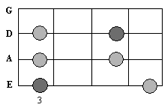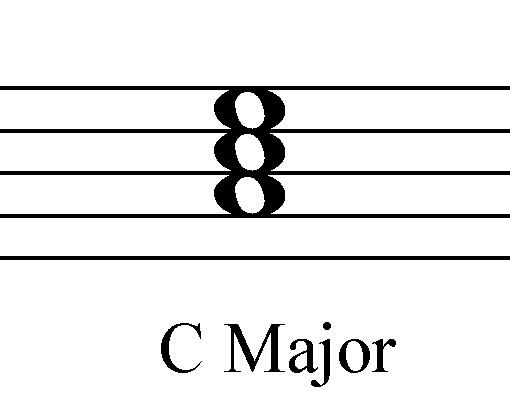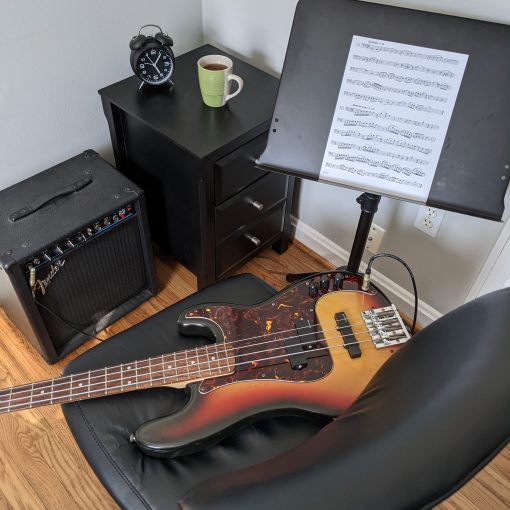Level: beginner
No part of this lesson may be copied, reproduced, or distributed in any form without consent of the author. Copyright © Doug Ross, all rights reserved.
In a previous lesson, I introduced the Major Pentatonic scale and gave an example of its use in creating walking bass lines over a blues chord progression. If you’re not already familiar with Major Pentatonic, I recommend that you review that lesson first because it is probably the most commonly used scale for playing all sorts of fundamental bass lines in major keys (not just the blues).
Guitar players, on the other hand, tend to be particularly enamored of a different pentatonic scale. The Minor Pentatonic is the other 5-note scale also widely used in popular music. As the name suggests, it is based on the shape of a natural minor scale, leaving out the 2nd and 6th degrees. Here is the fingering:

As it turns out, this scale is related to the previously mentioned Major Pentatonic. In fact, the above G Minor Pentatonic scale (G – Bb – C – D – F – G) contains exactly the same notes as the Bb Major Pentatonic scale (Bb – C – D – F – G – Bb). The difference is just a matter of whether you resolve to Bb or to G when using the scale. If you resolve to G, it will sound rather dark, with kind of a rough, bluesy attitude. You might be tempted to bend some strings along the way! If you resolve to Bb, on the other hand, it will tend to sound “happier” and more consonant, with perhaps a bit of a country flavor. Guitar players like that bluesy stuff, so they tend to go for the Minor Pentatonic version a lot.
Here’s where it gets a little confusing. You might assume that, since our Major Pentatonic scale is good for playing on major chords, our Minor Pentatonic would be good for playing on minor chords, and you would be right! However, the Minor Pentatonic can also sound good over major chords sometimes, particularly over dominant 7 chords, which we use a lot in the blues. In fact, we could use the above G Minor Pentatonic scale to play a solo or a melody right over the G Major Pentatonic blues bass line you learned in the previous lesson — weird, huh? Listen to any Stevie Ray Vaughan solo and you’ll hear him doing it. You have to use your ears a bit to make it work, but it can be very effective. The reason why this “minor” scale can sound good in a major key is actually kind of complicated and not important for now, but it has to do with adding tension through upper chord extensions.
One important difference in the use of these two pentatonic scales is that, while the Major Pentatonic pattern usually shifts to start on the root of each new chord, the Minor Pentatonic scale usually is played only from the root of the key of the song. So on our G blues example from the previous lesson, you could use G Minor Pentatonic over all three chords (not C Minor Pentatonic or D Minor Pentatonic). There are exceptions to this and more advanced uses to learn later on.
So it might be useful to think of the Major Pentatonic as your “go to” scale for bass lines (in major keys), and the Minor Pentatonic as a better scale for soloing and adding melodic licks with a bluesy flavor. Not a bad rule of thumb, I think. Of course, in minor keys, the Minor Pentatonic will be your “go to” scale. It does get used in bass lines of songs in both major and minor keys, like “Crossroads” by Cream, or “I Shot the Sheriff” by Bob Marley, and lots of other rock tunes. Here is an example bass line:

There is also a slight variation of the Minor Pentatonic scale that you should know about. It’s called the Blues Scale, and it is exactly the same as Minor Pentatonic, with one added note. Starting from G, it contains the notes G – Bb – C – C# – D – F – G:

This extra note is usually used to slide or bend into the higher note (D) or the lower note (C) for extra bluesy effect. Functionally, though, it’s pretty much the same thing as Minor Pentatonic. Here’s a Blues Scale riff for you:




